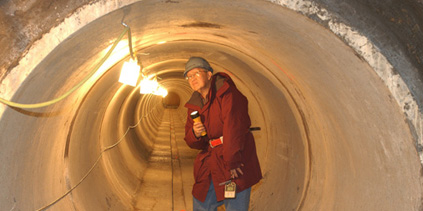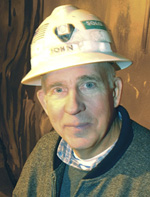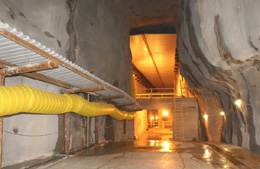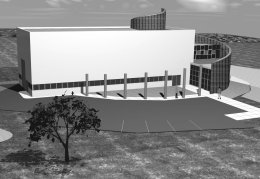 |
|
First Phase of NuMI Construction Complete by Kurt Riesselmann
At 219 feet, Wilson Hall is Fermilab’s tallest building. It offers one of the longest elevator rides in the Fox Valley area: sixteen stories. Since November, Fermilab employees can take an even longer elevator ride. Construction workers have completed the installation of a new 30-story elevator. At the final stop, however,passengers won’t get a view of Chicago’s skyscrapers. Instead, passengers exit into a vast, windowless hall that could easily serve as a small cathedral. The 120-foot-long cavern, called the MINOS hall, is located 350 feet underground. In two years, it will host the Main Injector Neutrino Oscillation Search experiment, a research project carried out by two hundred physicists from five countries. The experimenters will study the properties of neutrinos, one of the least understood types of particles in the universe. Supervising the installation of the elevator was one of the last tasks carried out by the S.A. Healy company, which has been responsible for Phase I of the Neutrinos at the Main Injector construction. The NuMI project included the excavation of two access shafts, four thousand feet of tunnels, two large underground halls and several alcoves. On November 22, Healy finished its 30.5-million-dollar contract, which it was awarded in spring of 2000. “There has been significant progress in the NuMI underground area since my last tour in September 2001,” said NuMI program manager Phil Debenham, who monitors the NuMI project on behalf of the Department of Energy.“My strongest impressions on this visit [at the end of October] were the length of the excavation and the interesting texture of the surfaces created by blasting. The overall progress on the project since [our last ]Lehman review in May appears good.” Ragnar Benson Inc., of Park Ridge, Illinois will carry out the next phase of the NuMI/MINOS construction, an 18-million-dollar contract. Its employees are already using the new elevator to access the underground area. “It is certainly a better environment than I thought it would ever be,” said Fermilab engineer Tom Lackowski.“You almost have the feeling you are inside a building. The physicists — the end users — are very happy.”
John Sollo, engineer at MWH Global Inc.and NuMI construction coordinator,agreed. “The most satisfying thing is to see and hear how pleased the scientists are with how the site looks,” he said. “[Fermilab physicist and NuMI project manager] Greg Bock said it looked `beautiful.’ I’ve never thought that way about any underground work myself.” In May 2002, Healy miners removed the last pieces of rock from underground. Over the summer, workers installed a 2,000-foot long steel pipe, six feet in diameter. They surrounded it with one thousand truckloads of concrete — 25,000 cubic yards. When in operation, short-lived particles such as pions will decay inside the pipe and produce the treasured neutrinos, ghost-like particles that MINOS scientists want to study in great detail. “When you are pouring 8-foot-thick concrete around a pipe, all kinds of things can go wrong,” said Lackowski.“Getting the decay pipe in better than the specified tolerances is a great success.” Aiming the neutrinos in the right direction is the most critical aspect of the MINOS experiment. Scientists will examine the beam of neutrinos at two locations. First, the neutrinos will traverse a detector inside the MINOS hall, about 1,000 feet away from the end of the decay pipe. The neutrinos will continue their journey past the detector and travel straight through 450 miles of rock — no tunnel needed — before entering a second detector located inside an old iron mine in Soudan,Minn. Scientists will then compare the results obtained from both near and far detectors to check for neutrino oscillations, the transformation of neutrinos while traveling a long distance. To ensure that the neutrinos leave the Fermilab site in precisely the right direction, a crew of Fermilab surveyors has worked in the NuMI tunnels almost every day. “We set up a control network in the tunnel,” explained Gary Crutcher, who heads a crew of four. “We are continually tightening up all control points down there. [The S.A.Healy subcontractor] Precision Survey has done a very good job. We found little discrepancy between the work they did and we did.” The NuMI tunnels have up to a six percent slope, pointing directly at the Soudan mine. The actual location of the decay pipe within the tunnel is well within the three quarters of an inch tolerance specified by NuMI scientists, a great accomplish- ment by everybody involved. Planning the NuMI/MINOS project has taken many years.
“I’ve been working on this project since ’94,” said Lackowski, who belongs to the Facilities Engineering Services Section at Fermilab.“The gestation period for these experiments is quite long. If you look at the early designs, they were quite different. We began with tunnels that were only half as long. Eventually, we got to a baseline, a technical design report.” Since FESS engineers had limited experience with deep underground construction, Fermilab hired Chris Laughton, an engineer who had worked on the Large Electron-Positron collider construction in Switzerland. In addition, the construction companies Fluor Daniel and Harza (now part of MWH Global) helped with the site selection for the NuMI tunnels. Sollo, who has worked for Harza and other companies on underground construction projects around the world, appreciated the cooperation between Fermilab’s engineering group and the various contractors. “Tom Lackowski was one of the key players in getting this project done,” said Sollo.“He knew the design in great detail, and he knew what would or would not work when changes had to be made.” With the end of Phase I, Sollo is done with his work at Fermilab. In November, he and his colleague Mike Bruen turned over 190 ring binders with field data —drawings, correspondence, reports, submittals, survey data —to Fermilab. “Now it’s back to what the FESS engineers are familiar with,” Sollo said.“The underground work was a little different.” Fermilab engineer Elaine McCluskey will lead the next construction phase. She will coordinate the work by Ragnar Benson Inc. The company will work on outfitting the underground areas as well as the construction of two service buildings right on top of the access shafts. “The next phase of the NuMI construction is a fairly complicated project from the logistics point of view,” explained McCluskey. “We have an aggressive schedule. We have to really pay attention to how the project is managed. That also means that the contractor has to pay close attention to the subcontractors ’work.”
Ragnar Benson Inc. has been in business for about 80 years, and its local credentials include the construction of two large glass buildings for Lucent Technologies, just five miles east of Fermilab. “Healy is leaving us with finished floor and shotcrete-lined walls and ceiling,” McCluskey said. “Ragnar Benson still needs to pour two thousand cubic yards of concrete, which is nothing compared to the amount of concrete poured by Healy. We are also going to install large cranes. To satisfy regulations by the National Fire Protection Association, we also need to build life-safety passage ways inside the tunnels.” Above ground, Ragnar Benson will start from scratch. The company will construct two buildings right above the access shafts to the tunnels. “The purpose of these two buildings is to bring material underground and supply utilities to the experiment,” said McCluskey.“We are building what the experiment needs. To provide cooling, there will be heat exchangers and chillers. We also need to install plumbing and ventilation. Ventilation is no small matter. You can imagine what it takes to ventilate such a large tunnel.” According to the contract, Phase II will be completed in fall of 2003. Fermilab scientists will then begin to install the beam line and near detector. In early 2005, the first neutrinos will take their trip to Minnesota. It will take them about one thousandth of a second, even without a tunnel.
ON THE WEB:
|



